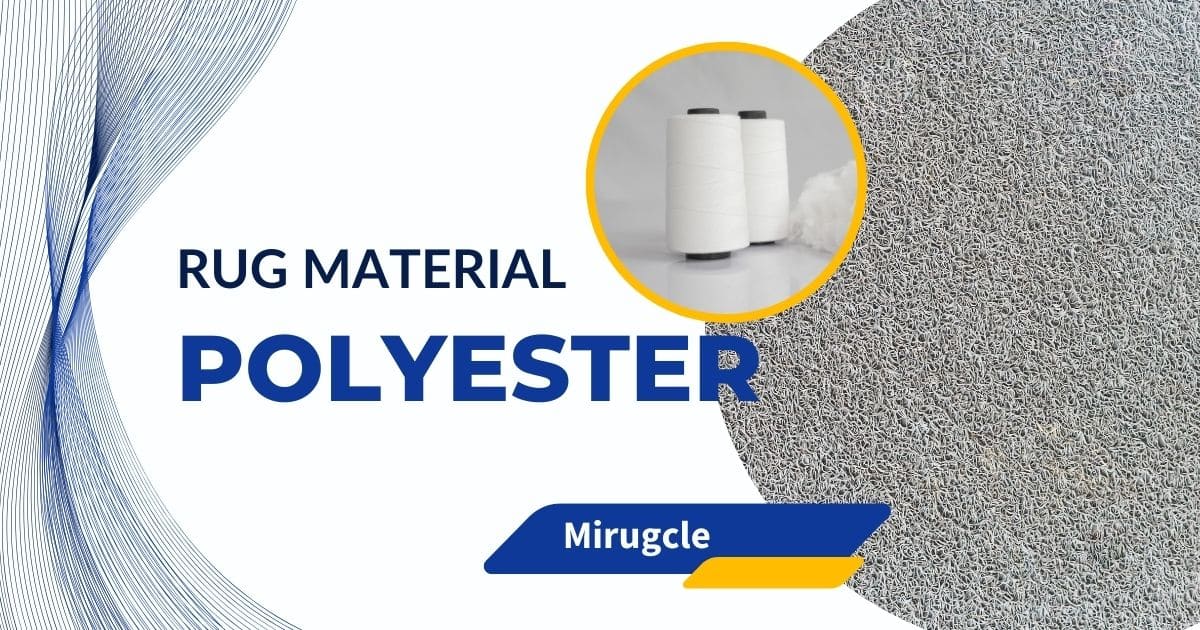Wondering if a polyester rug is the right choice for you?
In this blog post, we’ll delve into the physical characteristics, benefits, and drawbacks of polyester rugs.
You’ll learn about their affordability, vibrant colors, and easy maintenance.
We’ll also compare polyester to wool rugs in terms of durability, comfort, and eco-friendliness.
Start reading now to find the perfect rug for your needs!
Polyester is a synthetic fiber made from petrochemicals that is commonly used to make rugs and carpets.
Physical Parameters
Here are the key physical parameters of polyester fiber with some basic numerical values:
- Density: Polyester has a density of 1.38-1.40 g/cm^3.
- Tenacity: The tenacity of polyester is quite high, varying from 2.5-9.5 g/denier.
- Elongation at break: Polyester fibers typically have an elongation at break of 15-45%.
- Elastic recovery: Polyester fibers have good elastic recovery, generally around 90-99% recovery from 2% stretch.
- Moisture regain: Polyester has low moisture absorption, with a moisture regain of only 0.4-0.8% at standard conditions (21°C, 65% relative humidity).
Thermal properties:
- Melting point: Polyester melts at 480°C.
- Softening point: The softening point of polyester is around 460°C.
- Thermal conductivity: Polyester has a thermal conductivity of 0.12-0.17 W/mK.
- Specific heat capacity: The specific heat capacity of polyester is 0.9-1.4 J/gK.
- Refractive index: Polyester fibers have a refractive index of 1.57-1.58.
- Denier: Polyester fibers are available in a wide range of deniers, commonly from 0.9 to 25 denier per filament.
- Fiber length: Polyester staple fibers are typically produced in lengths ranging from 25 mm to 76 mm.
- Abrasion resistance: Polyester has high abrasion resistance, though slightly lower than nylon.
These physical parameters help determine the suitability of polyester fibers for various applications in textiles, including rugs and carpets.
The high tenacity, good elastic recovery, and low moisture absorption make polyester a durable and easy-to-maintain material for rugs.
Advantages of Polyester
Some key characteristics of polyester rugs include:
- Affordability – Polyester rugs are generally less expensive than rugs made from natural fibers like wool, since polyester is cheaper to manufacture.
- Durability – Polyester fibers are strong and resistant to wear, making the rugs quite durable, though not as long-lasting as some natural materials.
- Stain resistance – Polyester rugs repel moisture and are resistant to many stains, making them easy to clean and maintain.
- Vibrant colors – The synthetic fibers can be dyed easily to produce rugs in a wide variety of bright, vibrant colors and patterns.
- Softness – Polyester rugs have a very soft, plush feel, though the fibers may flatten over time.
Disadvantages of Polyester
However, polyester rugs also have some potential drawbacks:
- Not eco-friendly – Polyester is made from non-renewable petrochemicals and the rugs can shed microplastics.
- Prone to static and shedding – The rugs can generate a lot of static electricity and may shed fibers, especially when new.
- Flammable – Polyester fibers are flammable and can melt when exposed to high heat.
So in summary, polyester provides an affordable, durable, and easy-to-clean synthetic rug material, available in many colors and styles.
But it lacks some of the long-term durability and eco-friendliness of natural fibers like wool.
Polyester rugs are a popular choice for many homes, especially in high-traffic areas.
Pick Polyester or Wool?
Here are some key factors to consider when deciding between polyester and wool rugs:
Budget and Cost
- Polyester rugs are generally much more affordable than wool rugs.
- If budget is a primary concern, polyester may be the better choice.
Durability and Lifespan
- Wool rugs are more durable and can last for decades with proper care.
- Polyester rugs typically only last 3-5 years, especially in high-traffic areas.
- However, if you like to change your decor frequently or the rug is for a temporary space, the shorter lifespan of polyester may be acceptable.
Stain and Moisture Resistance
- Polyester has excellent resistance to water-based stains and dries quickly.
- It’s a good choice for dining rooms, kids’ rooms, or other spill-prone areas.
- Wool is naturally stain-resistant but can be permanently stained if spills are left untreated.
Professional cleaning is often needed.
Softness and Comfort
- Polyester rugs are known for their soft, plush, luxurious feel that is comfortable underfoot.
- Wool is also very soft, but polyester can sometimes even mimic the feel of wool at a lower price point.
Color Variety
- Polyester can be dyed in a wider range of rich, vibrant colors and intricate patterns compared to wool.
- The colors also tend to be more fade-resistant over time in polyester.
Eco-Friendliness and Safety
- Wool is a natural, renewable, biodegradable fiber that is safer for indoor air quality.
- Polyester is made from petrochemicals, may off-gas VOCs, is not biodegradable, and can shed microplastics.
It’s a less eco-friendly choice.
In summary, polyester is best for those on a budget who need a rug that is soft, stain-resistant, easy to clean, and comes in vibrant colors – ideal for kids’ rooms, dining areas, or temporary spaces.
Wool is better for those who prefer a natural, eco-friendly, heirloom-quality rug and are willing to invest more for a durable, long-lasting option.
Consider your priorities in terms of cost, comfort, durability, safety, and style when choosing between polyester and wool rugs.

